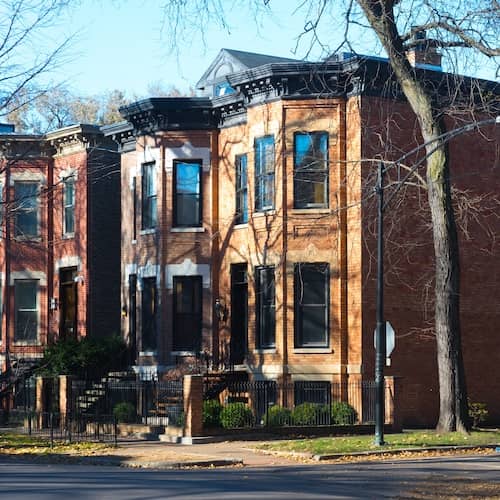What is a vacancy rate and how is it calculated?
Contributed by Sarah Henseler, Tom McLean
Jun 16, 2025
•5-minute read

If you’re thinking of investing in a rental property, understanding vacancy rates is essential. Vacancy rates show how many units in a property are rented and how many are empty. They also indicate whether a property is operating efficiently and its future earning potential.
What is a vacancy rate?
Vacancy rate – sometimes called a physical vacancy rate – is the percentage of rental units in a property that are unoccupied over a given period. Vacancy rates are the inverse of occupancy rates. A higher vacancy rate suggests a property may have problems such as outdated units, weak management, a poor location, or overpriced rent. Low vacancy rates suggest a rental property is in demand, is run well, affordably priced, and generates a steady income.
How to calculate vacancy rate
There are two ways to calculate a property’s vacancy rate.
For the percentage of unoccupied units in a building, the formula is:
Vacancy rate = (vacant units / total units) x 100.
For example, if an apartment building has 11 vacant units out of a total of 120, the vacancy rate is:
(11 / 120) x 100 = 9.2%
For the percentage of time a unit has been vacant, the formula is:
Vacancy rate = (vacant days / available days) x 100.
Say a single rental unit was vacant 23 days out of the year:
(23 / 365) x 100 = 6.3%
Because vacancy rates between 5% and 10% are considered healthy, these percentages suggest the property is prosperous, well-run and priced properly.
Vacancy rate for portfolios or multiunit properties
What if you own or are interested in investing in a multifamily building or a portfolio of units and want to assess their vacancy rate in aggregate? Easy. Just total the number of vacant days across all units and divide by the number of total rentable days. Here’s an example of what that might look like:
| Unit | Days Vacant | Days Available |
|---|---|---|
| 1 | 35 | 270 |
| 2 | 47 | 365 |
| 3 | 20 | 310 |
| 4 | 12 | 335 |
| Totals | 114 | 1,280 |
Vacancy rate = (114 / 1,280) x 100 = 8.9%
Current residential vacancy rate trends
Since 2022, the national residential vacancy rate has been creeping up slightly year to year. As of the first quarter of 2025, the national rental vacancy rate stands at 7.1%, an increase from 6.6% in the same quarter of 2024. So, despite the vacancy rate being well below 10% nationally, it suggests a growing supply.
Of course, our country is large and national statistics can mask what’s taking place in specific areas. For example, Austin, Texas, has seen a massive rise in vacancy rates, hitting 9.85% for two-bedroom apartments in early 2025. That’s up from just 3.97% in late 2021. That’s resulted in rent prices going down as renters have more negotiating power.
And down in Tampa, Florida, multifamily vacancy rates have topped 10% for the first time in 15 years. The addition of 7,400 units last year, with 11,000 more expected in 2025, is contributing to the rise, despite healthy tenant demand.
These two examples emphasize why it’s important to do your homework on local market vacancy rates and economic conditions to get a clear picture of your investment.
What high vacancy rates may indicate
Acceptable vacancy rates can vary by region, market conditions, and other factors, but typically, a healthy vacancy rate tends to be between 5% and 10%. So what does a high vacancy rate mean?
It could point to problems with the overall market, of course, and signal that demand is far below supply. However, if your property is experiencing higher vacancy rates than the properties in your region, it could point to problems specific to your property.
For instance, it could be as simple as a marketing or advertising issue. It could also indicate outdated or unappealing units that need renovations, or that the units are overpriced for the current market.
What low vacancy rates may indicate
Low vacancy rates usually indicate a strong market, with demand for rentals outstripping supply. They could also mean a property is well-managed and desirable. Landlords might have more options for well-qualified tenants.
Low vacancy rates, in hand with good management, could also mean that a property is maximizing its profitability, making it an attractive investment.
Understanding and calculating the economic vacancy rate
There is another type of vacancy rate that many investors view as an even better indicator of a property’s investment potential and likely profitability. That’s the economic vacancy rate.
The economic vacancy rate measures the difference between a property’s gross potential rent (GPR) and its actual rental income. The advantage of this is that the economic vacancy rate takes into account important factors other than mere vacancy numbers.
For instance, the economic vacancy rate includes units that are occupied but not generating rent, such as property manager units, promotions like free weeks or months of rent for new tenants, and even unrealized income due to units being rented under the market rate.
So, to calculate this, use this formula:
Economic vacancy rate = (gross potential rent – actual rental income) / gross potential rent x 100
Here’s an example:
Let’s say a property has 100 units with an average rent of $2,000. The market rent for the area is $2,100. Further, there is one unit for the property manager, who pays no rent, and seven vacant units.
The gross potential rent for the building is $2,100 x 100 = $210,000
The actual rental income is $2,000 x (100 - 8) = $184,000
Economic vacancy rate = ($210,000 - $184,000) / $210,000 x 100 = 12.38%
What market vacancy rate tells investors
The market vacancy rate is another important metric to understand. This is a reflection of the average percentage of unoccupied rental units in a specific region. It can put your property’s vacancy rate in context and help you make decisions about buying, selling, renovating, and more.
Where to find market vacancy rate data:
- U.S. Census Bureau’s housing data
- Local government websites
- Real estate agents and property managers
- Online listing services and market research tools
What high market vacancy rates can tell you
A high market vacancy rate could indicate an excess of rental units in the area, suggesting that supply outpaces demand. These market conditions could be risky for investment. Knowing this could also give you negotiating leverage.
What low market vacancy rates can tell you
Low market vacancy rates could suggest a strong housing market with high demand and limited supply. This environment could be safer for investment. Of course, the sellers also understand this and it could make scoring an undervalued property at a bargain price tougher.
The bottom line: Use vacancy rates to make smarter investments
The various types of vacancy rates are more than just simple calculations. They give you valuable insights into whether a rental property is a potential passive money maker or a headache-inducing bank breaker. Their ease of use combined with their importance of information make them a go-to tool for any real estate investor. If you’re interested in building wealth through rental real estate, Rocket can help you use these tools to your advantage. We have helped thousands just like you in all stages of their real estate journey.

Terence Loose
Related resources
7-minute read
Most promising and best places to invest in real estate in the U.S.
Learn about the 10 best cities to invest in real estate in 2024 based on house price index, median home sold price, gross rental yield and vacancy rate.
Read more

5-minute read
How to determine a good investment property: Here’s what to look for
It’s essential to know how to identify a good investment property before choosing one. Read our helpful guide to know what to look for during your hunt...
Read more
6-minute read
Managing rental properties: A landlord's complete guide
Managing rental properties includes tenant management, property maintenance and organizing your finances. Learn some property management tips and tricks.
Read more